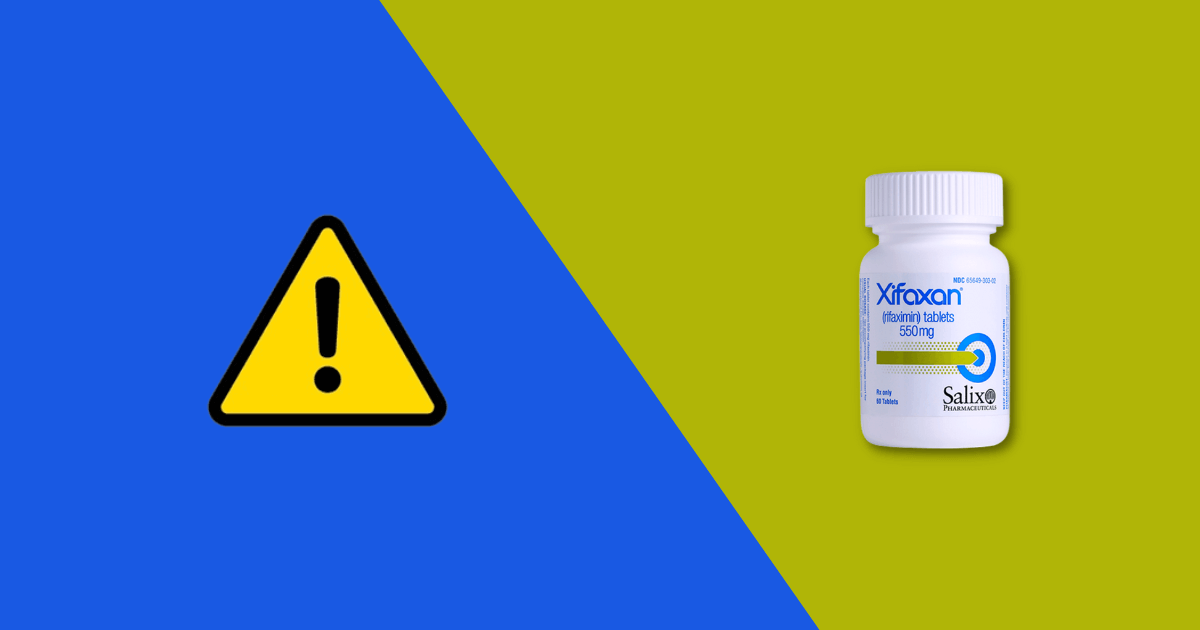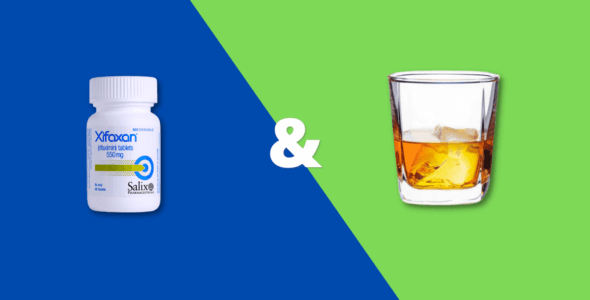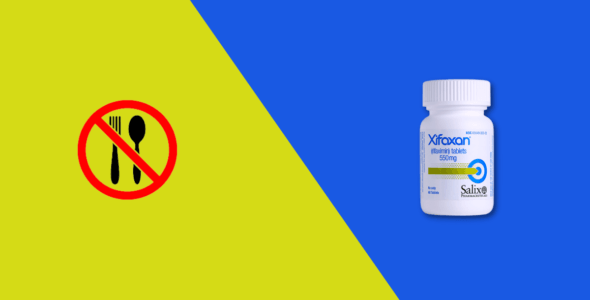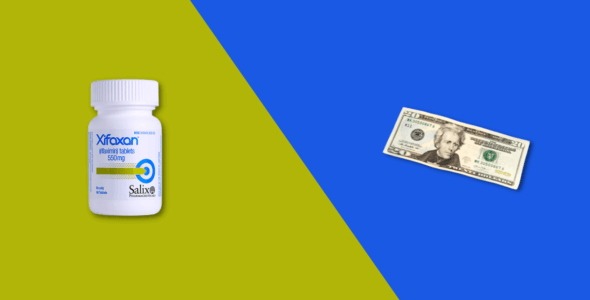Xifaxan side effects and how to avoid them
Key highlights
- The most common side effects of Xifaxan include headaches, swelling of the legs or abdomen due to fluid accumulation, nausea, extreme tiredness, and dizziness.
- Less common, but serious side effects include rash, hives, itchiness, difficulty breathing or swallowing, hoarseness, watery or blood-stained diarrhea along with fever and stomach cramps, and swelling of the face, lips, tongue, throat, eyes, hands, or legs.
Table of contents
Xifaxan® is an FDA (U.S. Food and Drug Administration) approved antibacterial medication manufactured by Salix Pharmaceuticals. It is used for the treatment or prevention of infections that are caused by bacteria only. Primarily for treating travellers’ diarrhea (TD) caused by Escherichia coli in patients of 12 years of age or older, irritable bowel syndrome with diarrhea (IBS-D) in adults, and reducing the recurrence risk of overt hepatic encephalopathy (HE) in adults.
While Xifaxan is generally safe and well-tolerated, there are some potential side effects that people should be aware of. The most common side effects of Xifaxan include headaches, swelling of the legs or abdomen due to fluid accumulation, nausea, extreme tiredness, and dizziness. Not everyone treated with Xifaxan will experience all of these side effects. It depends on the condition being treated. Less common, but serious side effects include rash, hives, itchiness, difficulty breathing or swallowing, hoarseness, watery or blood-stained diarrhea along with fever and stomach cramps, and swelling of the face, lips, tongue, throat, eyes, hands, or legs.
Learn more about the side effects of Xifaxan and what you can do to avoid them.
What is Xifaxan (rifaximin)?
Xifaxan is an antibacterial drug that contains rifaximin as an active ingredient. Rifaximin is a gut-selective, nonsystemic and oral antimicrobial agent. It acts only in the gastrointestinal tract and therefore causes minimal side effects compared to systemic antibiotics. It works by binding to the beta-subunit of bacterial DNA-dependent RNA polymerase. It prevents bacteria from synthesizing proteins and, in turn, inhibits bacterial growth.
Xifaxan dosage
It is available in tablet form in 200 mg and 550 mg strengths. It should be taken at the same time every day with or without food. Take Xifaxan exactly as directed by your doctor or pharmacist. Your doctor will recommend the optimal dose depending on the medical condition to be treated.
For the treatment of TD, 200 mg tablets are prescribed thrice a day for 3 days.
For the treatment of HE, 550 mg tablets are prescribed twice a day.
For the treatment of IBS, 550 mg tablets are prescribed thrice a day for 14 days.
What are the side effects of Xifaxan?
Most common side effects of Xifaxan:
- Headaches
- Swelling of legs or abdomen due to fluid retention
- Nausea
- Extreme tiredness
- Dizziness.
Rare and serious side effects of Xifaxan:
- Hives
- Rash
- Itchiness
- Difficulty breathing or swallowing
- Hoarseness
- Swelling of the face, lips, tongue, throat, eyes, hands, or legs
- Watery or blood-stained diarrhea along with fever and stomach cramps
If you experience any of these serious side effects, stop taking Xifaxan and seek medical attention immediately.
You are encouraged to report the adverse effects of prescription drugs to the FDA by visiting www.fda.gov/medwatch or calling 1-800-332-1088.
Side effects of SIBO treatment with Xifaxan
SIBO (Small Intestinal Bacterial Overgrowth) is an abnormal condition characterized by excessive growth of bacteria in the small intestines. Xifaxan is not FDA-approved for SIBO treatment but is indicated for off-label use. Research has shown that Xifaxan can help manage SIBO. As Xifaxan acts only in the gastrointestinal tract, it causes fewer side effects including nausea, constipation, fatigue, gas formation, and headache.
It rarely affects liver functions, worsens diarrhea in some people, and can lead to gut infections by promoting the growth of Clostridium difficile.
How long do Xifaxan side effects last?
Xifaxan side effects are temporary and subside quickly within a day or two. Rarely, it causes overgrowth of C. difficile and puts you at risk for CDAD. While some side effects may require additional treatment. Speak to your doctor about what side effects you face, how long they last, and how to manage them at home.
What are the side effects of Xifaxan after stopping?
Xifaxan is considered a safe medication. There won’t be any side effects after stopping the use.
Xifaxan long-term side effects
According to the information available to date, Xifaxan has no long-term side effects unless you have lung disease.
Anxiety side effects
Anxiety can fill your brain with racing and unwanted thoughts, unnecessary worries, fears, irregular heartbeat, sleeplessness, and many more. Try to relax by practicing nurturing habits like drawing, painting, socializing, walking barefoot on the grass, or taking a warm water bath.
Fatigue side effects
Fatigue can make you suffer from moodiness, tiredness, lack of interest, sleepiness, and many more. To overcome this, exercise regularly and do activities that make you feel happy and energized.
Xifaxan side effects with alcohol
Consuming alcohol while on Xifaxan treatment is neither hazardous nor safe. According to a study conducted by the American College of Gastroenterology, alcohol consumption can impact gut health and causes bloating, abdominal pain, gas, diarrhea, or constipation. So, it’s better to avoid alcohol during this treatment.
Foods to avoid while taking Xifaxan
There is no strong evidence on the foods to avoid while on Xifaxan, but patients with IBS are advised to avoid:
- Dairy products
- Insoluble fiber foods (certain fruits and vegetables, and whole grains)
- Deep-fried foods
- Caffeinated drinks
- Processed foods
- Gluten or wheat
- Garlic, onions, broccoli, and cauliflower
- Alcohol
- Chocolates or sugar-free sweeteners
Patients with TD are advised to avoid:
- Raw leafy vegetables (spinach, lettuce, and cabbage)
- Unpeeled or unwashed vegetables or fruits
- Undercooked meats
You can replace the above foods with eggs or well-cooked meat, fish, almond milk, grains (oats, rice, corn, quinoa), cheeses (cheddar, feta, brie), vegetables (tomatoes, potatoes, cucumbers, zucchini), tofu, pumpkin seeds, sesame seeds, sunflower seeds, and fruits (bananas, blueberries, kiwi, strawberries).
You can consult a registered dietitian or nutritionist if you want to get a personalized diet menu based on your condition.
Xifaxan drug interactions
Xifaxan can interact with other medications including:
- P-glycoprotein inhibitors+ Xifaxan
This combination increases the systemic exposure of rifaximin.
- Warfarin + Xifaxan
This combination alters blood clotting times. So, warfarin dose adjustment is required.
- CYP3A4 Substrates + Xifaxan
A study discovered that Rifaximin induces CYP3A4, an important enzyme found in the liver and intestines. This combination may deactivate the drug. However, in patients with normal liver function, optimal doses of Xifaxan do not induce CYP3A4. But its effect in patients with compromised liver function is still unknown.
This list is not exhaustive and other prescription drugs may also interact with Xifaxan. Tell your healthcare provider about all of the medicines you take, including prescription and over-the-counter medicines, vitamins or nutritional supplements, and herbal products.
Xifaxan warnings & precautions:
You should not use Xifaxan if you:
- Are allergic to the active ingredient rifaximin
- Are allergic to any of the Xifaxan ingredients
- Have travelers’ diarrhea that is not caused by E. coli or strongly suspected bacterial infection. If prescribed in this condition, it may not benefit the patient and increases the risk of developing drug-resistant bacteria.
- Have Clostridium difficile-associated diarrhea (CDAD). CDAD has been reported following the use of antibacterial agents. These agents alter the normal flora of the colon, leading to the overgrowth of C. difficile and increasing mortality. These infections are unresponsive to antimicrobial therapy. So a history of CDAD should therefore be carefully evaluated in patients with diarrhea even after antibiotic use.
Use with caution:
- In patients with severe hepatic impairment
- During concomitant administration with P-glycoprotein inhibitors
Talk to your doctor before using Xifaxan if you:
- Have a fever or blood-stained stools
- Have or ever had liver disease
- Are a pregnant or planning to conceive or breastfeeding
- Are taking or have ever taken prescription or OTC medications, vitamin or nutritional supplements, or herbal products
You should always check with your doctor or pharmacist before taking any medication, including Xifaxan, to make sure it is safe for you.
How to avoid Xifaxan side effects?
The best way to avoid side effects is to take Xifaxan as directed by your doctor. Follow your doctor’s instructions carefully and do not take more or lesser doses than prescribed.
If you experience any unusual side effects, talk to your doctor or pharmacist. They may be able to recommend ways to help reduce or prevent some of the Xifaxan side effects.
Inform your doctor if your diarrhea persists or worsens 24 to 48 hours after taking Xifaxan. Your doctor will discontinue Xifaxan and choose other antibiotics. Adapt the below activities to avoid Xifaxan side effects:
1. Stick to the recommended dose
Take Xifaxan exactly as recommended by your doctor. Do not take more or lesser doses than prescribed.
2. Monitor yourself
Like all medicines, Xifaxan also has some side effects. So, keep an eye on the signs and symptoms of any side effects you may face during Xifaxan treatment. Consult your doctor right away if any unusual symptoms occur and get the necessary medical attention.
3. Follow a healthy lifestyle
Xifaxan can cause a variety of side effects. So, have a healthy diet and lifestyle to better manage the side effects at home. A healthy lifestyle can also help you recover faster.
4. Avoid alcohol consumption
Alcohol can cause gut problems like constipation or diarrhea, gas, bloating, and abdominal pain. So try to avoid alcohol or limit consumption.
5. Get your liver tested regularly
Xifaxan may interfere with normal liver functioning. So go for liver examination at specific intervals of time to ensure you are on safe treatment with Xifaxan.
6. Know the signs and symptoms of Xifaxan side effects
The most common signs and symptoms of Xifaxan side effects include but are not limited to headaches, peripheral edema, nausea, fatigue, ascites, and dizziness. If you experience any of these symptoms, consult your doctor for medical advice.
7. Tell your doctor about all medications you are taking
Be sure to tell your doctor about all other medications you’re taking, including over-the-counter medicines, vitamins, and herbal supplements, as they can interact with Xifaxan.
8. Get regular medical checkups
It is important to get regular medical checkups and monitor your treatment progression. Your doctor will monitor your condition and may adjust the dose of Xifaxan as needed.




